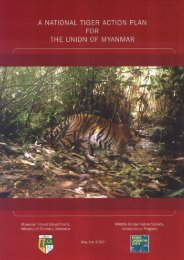Download - Global Tiger Initiative
Download - Global Tiger Initiative
Download - Global Tiger Initiative
Create successful ePaper yourself
Turn your PDF publications into a flip-book with our unique Google optimized e-Paper software.
Snow Leopard Survival Strategy and the Snow Leopard<br />
Network: Mobilizing knowledge and prioritizing conservation needs at<br />
global level<br />
In February 2001, the International Snow Leopard Trust initiated development of the Snow<br />
Leopard Survival Strategy (www.snowleopard.org/sln), by inviting 40 Snow Leopard experts<br />
from the 12 range States and from North America and Europe to participate in providing<br />
comprehensive conservation and research guidelines to ensure a co-ordinated effort to conserve<br />
Snow Leopards throughout their range. The Strategy was designed after thorough analysis of<br />
the threats facing the species in each range State and attempts to identify conservation,<br />
education and policy measures needed to address these threats, to determine the most urgent<br />
information needs and provide advice on appropriate methodologies.<br />
Information for the Strategy was gathered through a survey addressing various issues, including<br />
perceived threats, appropriate conservation actions, knowledge gaps, protected areas status and<br />
policy and legislative status. The results of the survey were compiled and the Strategy finalized<br />
at the Snow Leopard Survival Summit, that took place in May 2002, in Seattle, USA. The<br />
summit brought together fifty-two experts from 17 countries, including representatives from 11<br />
of the 12 Snow Leopard range States. Several new initiatives and recommendations were<br />
agreed upon, including the need for better co-ordination among the various organizations<br />
engaged in Snow Leopard conservation and for broader public awareness. A new group, the<br />
Snow Leopard Network, a partnership of organizations and individuals from governments and<br />
the private sector, was accordingly formed. The mission of this network is to promote sound,<br />
scientifically-based conservation of Snow Leopards, through networking and collaboration<br />
between individuals, organizations, and governments. To accomplish this, it will establish and<br />
strengthen professional links for addressing the crucial issues affecting the survival of the<br />
species itself, its prey species, and the livelihood opportunities of people living locally to Snow<br />
Leopards. The Snow Leopard Network will be chaired by the International Snow Leopard Trust<br />
for the first two years and a seven-member steering committee will set the direction for the<br />
group.<br />
CONCLUSIONS<br />
Despite their high-altitude existence, in rugged mountain terrain in some of the least populated<br />
areas on earth, Snow Leopards have probably been killed in numbers as high as ever before in<br />
recent years. Such killings are illegal, almost without exception, and often warrant a substantial<br />
penalty under national laws, yet they are nonetheless one of the most menacing threats posed to<br />
the survival of the Snow Leopard. The primary motives for these killings vary considerably<br />
between geographical regions, depending on social, economic, political and environmental<br />
factors. In general, poverty, economic instability, lack of resources and lack of awareness and<br />
political will are important root causes for these killings and any subsequent trade of Snow<br />
Leopard body parts. As such, enforcement of national laws to protect Snow Leopards is vexed<br />
by these factors, especially considering the attraction of high profits to be made from trading in<br />
Snow Leopard parts and the desire among herders to safeguard their stock from this predator.<br />
Such regulatory devices for controlling trade in Snow Leopards, although one of the approaches<br />
to conservation of the species, should by no means be seen as the only one. Since human<br />
communities living in or near Snow Leopard habitat are often operating at subsistence level, in<br />
FADING FOOTPRINTS: the killing and trade of Snow Leopards 53

















